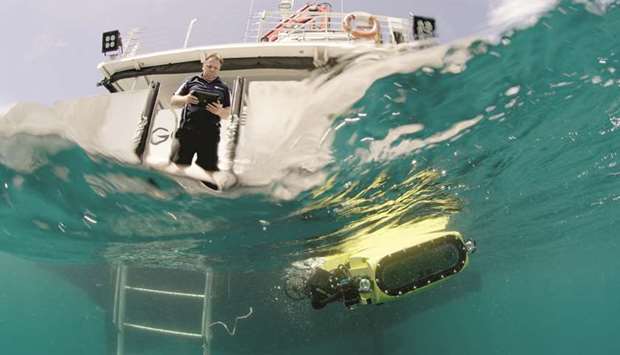The outbreak of coral-eating poisonous and thorny starfish is among a multitude of things currently damaging one of most biodiverse ecosystems on the planet - the Great Barrier Reef. The crown-of-thorns starfish (COTS), which is native to Australia, is one of world’s largest seastars, measuring up to 1 metre. The name is due to the venomous thorn-like spines that cover its upper surface.
The COTS preys upon coral polyps and could devastate large tracts of coral reefs if in outbreak numbers. Scientists say there are millions of them attacking the corals at the Great Barrier Reef, the world’s largest coral system, covering almost the size of Germany, and a top tourist spot in Australia.
Researchers at the Queensland University of Technology (QUT), in partnership with Google and the Great Barrier Reef Foundation, have recently invented ‘killer robots’ to tackle the starfish epidemic. Dubbed the ‘RangerBot,’ the underwater robotic device is fitted with high-tech real-time vision technology that allows it to navigate complex coral reefs in order to survey their health and detect COTS.
When it spots one, it fires off an injection of vinegar or bile salts to kill the starfish, with no harm to the reef. Matthew Dunbabin, the inventor and a professor at QUT, said the underwater hunter is able to identify the starfish with 99.4 percent accuracy. “We’ve trained RangerBot to detect crown-of-thorns starfish and only these coral-destroying starfish in much the same way as people learn to differentiate between various forms of sea life.” The little yellow submarine, weighing 15 kilogrammes and measuring 75 centimetres, operates with the help of a smart tablet. The robot is highly manoeuvrable, works for up to eight hours with a single charge and can operate at night and in shark- and crocodile-infested waters.
“RangerBot can stay underwater almost three times longer than a human diver,” Dunbabin said. He said the robot reef protector can also be equipped for surveillance of reef health, including monitoring for coral bleaching, water quality, pest species, pollution and siltation. “It can help to map expansive underwater areas at scales not previously possible, making it a valuable tool for reef research and management,” said Dunbabin, who first made the prototype in 2015.
“The high-tech, low-cost ‘drone of the sea’ has ‘the potential to revolutionise the way we manage our oceans” said Anna Marsden, managing director at the Great Barrier Reef Foundation. “More than a billion people depend on coral reefs for their food and livelihood, they stand to lose the most if those important ecosystems are not protected,”she said, adding that “effective management of the Great Barrier Reef is a mammoth and expensive task” due to its sheer size and complexity.
Stretching some 2,600 kilometres off Australia’s north-eastern coast, the Great Barrier Reef an assembly of 2,900 individual reefs is home to millions of marine lifeforms. It draws more than 2 million visitors and generates some $6.4 billion dollars a year. But in recent years, it has suffered from numerous problems, including sedimentation, water quality degradation, ocean acidification, back-to-back coral bleaching events in 2016-17 and a crown-of-thorns starfish epidemic.
According to a study, the Great Barrier Reef lost half its corals between 1985 and 2012 and COTS were responsible for more than 40 percent of that shrinkage. Sven Uthicke, Principal Research Scientist at the Australian Institute of Marine Science, said that only climate change is more responsible for the coral loss today than the COTS outbreak. The “exact number of COTS in the Reef region is difficult to predict, but there are several millions of them,” Uthicke said in a statement.
COTS are a natural part of the ecosystem, helping to increase coral diversity by feeding on the fastest-growing coral species, thereby allowing the slower-growing ones to form colonies. But if their density is greater than about 15 starfish per hectare, an outbreak occurs, as the COTS consume faster than the corals can grow. The most recent outbreak, the fourth since they were first recorded in the 1960s, started in 2010-11 and has moved from the northern reefs to the southern reefs, Uthicke said.
According to scientists, there are mainly two reasons for the outbreak of the crown-of-thorns starfish. One is a decrease in predators, such as the giant triton snail, and certain fish species, including humphead Maori wrasse, starry pufferfish and titan trigger fish. Few others feed upon larval or juvenile starfish.
The other is spikes in nutrients due to the increase of coastal and agricultural run-off into the ocean; the additional nutrients and sediments promote algae blooms, increasing the amount of food for many animals, including COTS larvae. Each female COTS can lay 60 million eggs in a single breeding season, which is from October to February, and if the timing of the spike in nutrient levels coincides with the spawning, it could see an outbreak, according to scientists. Culling programs led by tourism operators have already killed up to a million starfish, all by hand, one at a time. It’s hoped that the RangerBots can kill the coral-munching starfish quicker and with more efficiency.– DPA

FUNCTIONING: The robot fires off an injection of vinegar or bile salts to kill the starfish, with no harm to the reef.


